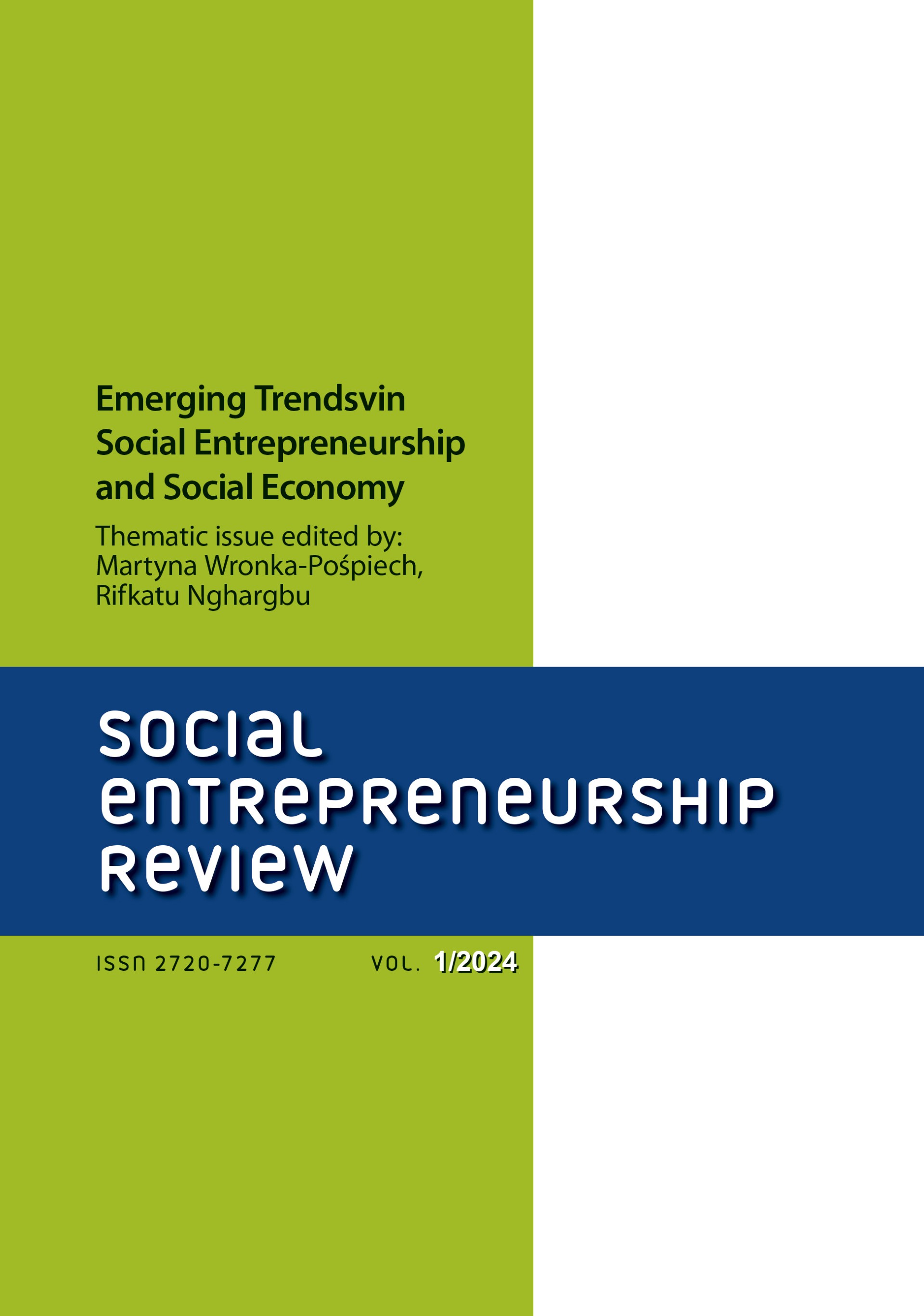The Role of Empathy in Designing Social Innovation For Blind and Visually Impaired People in Public Transportation in Poland
DOI:
https://doi.org/10.15678/SER.2024.1.02Keywords:
social innovation, design innovation, design thinkingAbstract
Background: The design thinking method is one way of modern service and product design. It encompasses various stages but places particular empathy. Trying to understand the customer’s needs and “stepping into the shoes” of the product user is the key.
Research objectives: The article aims to present the process of developing a social innovation using the design thinking method with particular empathy. It also indicates methods for supporting blind and visually impaired people in public communication and presents the developed social innovation as a case study.
Research design and methods: The article presents a literature review on design thinking, empathy, and social innovation. The case study presents the process of creating a social innovation. Key research questions concern the impact of empathy in the process of creating a social innovation. The research component also included interviews with blind and visually impaired people and a bus driver.
Results: We conducted a literature review was conducted. Based on it, we described the process of social innovation creation and the developed diagram. We presented the developed and tested innovation, as well as conclusions from the implementation and guidance for business practice.
Conclusions: empathy plays a key role in the design of modern services and products.
Downloads
References
Arabasz, M., & Sińczuch, M. (2016). Design thinking. Studio Graficzne Piotr Kurasiak.
Baran, G. (2016). Marketing współtworzenia wartości z klientem jako instrument tworzenia innowacji. Prace Naukowe Uniwersytetu Ekonomicznego we Wrocławiu, 458, 9–22. https://doi.org/10.15611/pn.2016.458.01
Bednarowska, Z. (2015). Desk research – wykorzystanie potencjału danych zastanych w prowadzeniu badań marketingowych i społecznych. Marketing i rynek, 7(2015), 18–26.
Brodnicki, K. (2015). Zastosowanie koncepcji design thinking w funkcjonowaniu przedsiębiorstw. Przedsiębiorstwo we Współczesnej Gospodarce – teoria i praktyka, 4, 35–45.
Brown, T. (2008). Design thinking. Harvard Business Review, 86(6), 84–92.
Brown, T. (2013). Zmiana przez design: jak design thinking zmienia organizacje i pobudza innowacyjność. Wydawnictwo LIBRON.
Cankurtaran, P., & Beverland, M. B. (2020). Using design thinking to respond to crises: B2B lessons from the 2020 COVID-19 pandemic. Industrial Marketing Management, 88(7), 255–260. https://doi.org/10.1016/j.indmarman.2020.05.030.
Chomątowska, B., Żarczyńska-Dobiesz, A., Janiak, A. M. (2019). Wykorzystanie wybranych narzędzi Design Thinking w budowaniu doświadczeń zróżnicowanych pokoleniowo pracowników. Przedsiębiorczość i Zarządzanie, 20(1), 171–187.
Cope, J. (2011). Entrepreneurial learning from failure: An interpretative phenomenological analysis. Journal of Business Venturing, 26(6), 604–623. https://doi.org/10.1016/j.jbusvent.2010.06.002.
CSTP. (2011). Fostering Innovation to Address Social Challenges. OECD.
Dahiya, A., & Kumar, J. (2018). How empathizing with persona helps in design thinking: An experimental study with novice designers. In Conference: IADIS International Conference Interfaces and Human Computer Interaction.
Dunne, D. (2018). Implementing design thinking in organizations: an exploratory study. Journal of Organization Design, 7(1), 7–16. https://doi.org/10.1186/s41469-018-0040-7
Ferreira, B., Silva, W., Oliveira, E., & Conte, T. (2015). Designing Personas with Empathy Map. In SEKE (Vol. 152).
Flick, U., Von Kardorff, E., & Steinke, I. (2004). What is qualitative research? An introduction to the field. A companion to qualitative research, 1, 3–11.
Helman, J., & Rosienkiewicz, M. (2016). Design thinking jako koncepcja pobudzania innowacji. In Knosala, R. (Ed.), Innowacje w Zarządzaniu i Inżynierii Produkcji, Oficyna Wydawnicza Polskiego Towarzystwa Zarządzania Produkcją, 62–72.
Kimbell, L. (2009). Beyond design thinking: Design-as-practice and designs-in-practice. CRESC Conference.
Li, C., & Bacete, G. (2022). Mapping the technology footprint in design for social innovation. International Journal of Innovation Studies, 6, 216–227.
Liedtka, J. (2013). Design Thinking: What it is and why it works. Darden School of Business.
Lockwood, T. (2009). Design Thinking: Integrating Innovation, Customer Experience, and Brand Value. Allworth Press.
Michalska-Dominiak, B., & Grocholiński, P. (2019). Poradnik design thinking – czyli jak wykorzystać myślenie projektowe w biznesie. Wydawnictwo Helion.
Meinel, C., & Leifer, L. (2011). Design Thinking Research. In Plattner, H., Meinel, C. & Leifer, L. (Eds.), Design Thinking. Understand – Improve – Apply. Springer – Verlag Berlin Heidelberg, 8–21.
Moulaert, F., MacCallum, D., Mehmood, A., & Hamdouch, A. (2014). The international handbook on social innovation: Collective action, social learning and transdisciplinary research, 21, 377–381. Edward Elgar Publishing.
Mulgan, G., Sanders, B., Ali, R., & Tucker, S. (2007). Social Innovation: what it is, why it matters, how it can be accelerated, The Young Foundation.
Murray, R., Caulier-Grice, J., & Mulgan, G. (2010). The Open Book of Social Innovation. NESTA.
Neumeier, S. (2012). Why do Social Innovations in Rural Development Matter and Should They be Considered More Seriously in Rural Development Research? – Proposal for a Stronger Focus on Social Innovations in Rural Development Research, Sociologia Ruralis, 52(1).
Pande, M., & Bharathi, S.V. (2020). Theoretical foundations of design thinking – A constructivism learning approach to design thinking. Thinking Skills and Creativity, 36.
Phills Jr, J. A., Deiglmeier, K., & Miller, D. T. (2008). Rediscovering Social Innovation, Stanford Social Innovation Review, 6(4), 34–43.
Rösch, N., Tiberius, V., & Kraus, S. (2023). Design thinking for innovation: context factors, process, and outcomes. European Journal of Innovation Management, 26(7).
Rudkin Ingle, B. (2015). Design thinking dla przedsiębiorców i małych firm. Potęga myślenia projektowego w codziennej pracy. Wydawnictwo Helion.
Sandu, S., & Anghel, I. (2016). Social innovation and innovation performance in the European Union, Annales Universitatis Apulensis. Series Oeconomica, 18(1), 57–69.
Schwarz, E. J. (2019). What sustainable development goals do social innovations address? A systematic review and content analysis of social innovation literature. Sustainability, 11(2), 522.
Sęk, M. (2015). Dobór próby przy pomocy metody kuli śniegowej (snowball sampling). In B. Fatyga (Ed.), Praktyki badawcze, 59–66.
Siemieniako, D. (2010). Rola empatii w budowaniu lojalności relacyjnej klientów. Zeszyty Naukowe Uniwersytetu Szczecińskiego. Problemy Zarządzania, Finansów i Marketingu, 15(608), 19–27.
Sobota, D. R., & Szewczykowski, P. P. (2014) Design thinking jako metoda twórczości. Filo-Sofija, 27, 91–113.
Sońta-Drączkowska, E. (2020). Design thinking w zarządzaniu projektami – ocena możliwości zastosowania. In E. Sońta-Drączkowska, & I. Bednarska-Wnuk (Eds.), Wybrane aspekty zarządzania procesami, projektami i ryzykiem w przedsiębiorstwach. Wydawnictwo Uniwersytetu Łódzkiego, 115–132.
TEPSIE. (2014). Social innovation theory and research: a guide for researchers. A deliverable of the project: “The theoretical, empirical and policy foundations for building social innovation in Europe” (TEPSIE), European Commission – 7th Framework Programme, Brussels: European Commission, DG Research
Wronka-Pośpiech, M. (2015). Innowacje społeczne – pojęcie i znaczenie, Zeszyty Naukowe UE w Katowicach, 212, 124–136.
Downloads
Published
Issue
Section
License
Copyright (c) 2024 Social Entrepreneurship Review

This work is licensed under a Creative Commons Attribution 4.0 International License.






